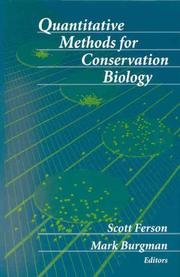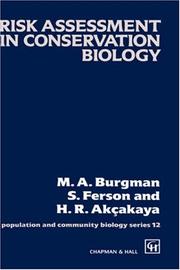| Listing 1 - 3 of 3 |
Sort by
|
Book
Abstract | Keywords | Export | Availability | Bookmark
 Loading...
Loading...Choose an application
- Reference Manager
- EndNote
- RefWorks (Direct export to RefWorks)
Biodiversity --- Animal population --- plant population --- Population distribution --- population genetics --- land use --- Resource conservation --- resource management --- Quantitative analysis

ISBN: 0387943226 9780387954868 0387954864 9780387226484 9786610145867 1280145862 0387226486 Year: 2000 Publisher: New York : Springer,
Abstract | Keywords | Export | Availability | Bookmark
 Loading...
Loading...Choose an application
- Reference Manager
- EndNote
- RefWorks (Direct export to RefWorks)
Quantitative methods are needed in conservation biology more than ever as an increasing number of threatened species find their way onto international and national “red lists. ” Objective evaluation of population decline and extinction probability are required for sound decision making. Yet, as our colleague Selina Heppell points out, population viability analysis and other forms of formal risk assessment are underused in policy formation because of data uncertainty and a lack of standardized methodologies and unambiguous criteria (i. e. , “rules of thumb”). Models used in conservation biology range from those that are purely heuristic to some that are highly predictive. Model selection should be dependent on the questions being asked and the data that are available. We need to develop a toolbox of quantitative methods that can help scientists and managers with a wide range of systems and that are subject to varying levels of data uncertainty and environmental variability. The methods outlined in the following chapters represent many of the tools needed to fill that toolbox. When used in conjunction with adaptive management, they should provide information for improved monitoring, risk assessment, and evaluation of management alternatives. The first two chapters describe the application of methods for detecting trends and extinctions from sighting data. Presence/absence data are used in general linear and additive models in Chapters 3 and 4 to predict the extinction proneness of birds and to build habitat models for plants.
Nature protection --- Biomathematics. Biometry. Biostatistics --- General ecology and biosociology --- Conservation biology --- Biologie de la conservation --- Statistical methods --- Mathematical models --- Méthodes statistiques --- Modèles mathématiques --- Conservation biology -- Mathematical models. --- Conservation biology -- Statistical methods. --- Electronic books. -- local. --- Ecology --- Earth & Environmental Sciences --- Statistical methods. --- Mathematical models. --- Life sciences. --- Community ecology, Biotic. --- Ecology. --- Life Sciences. --- Community & Population Ecology. --- Theoretical Ecology/Statistics. --- Ecology . --- Balance of nature --- Biology --- Bionomics --- Ecological processes --- Ecological science --- Ecological sciences --- Environment --- Environmental biology --- Oecology --- Environmental sciences --- Population biology --- Biocenoses --- Biocoenoses --- Biogeoecology --- Biological communities --- Biomes --- Biotic community ecology --- Communities, Biotic --- Community ecology, Biotic --- Ecological communities --- Ecosystems --- Natural communities --- Conservation biology.

ISBN: 0412350300 Year: 1993 Volume: vol 12 Publisher: London New York Tokyo Chapman & Hall
Abstract | Keywords | Export | Availability | Bookmark
 Loading...
Loading...Choose an application
- Reference Manager
- EndNote
- RefWorks (Direct export to RefWorks)
Animals [Protection of ] --- Conservation of wildlife --- Fauna--Bescherming --- Faune--Protection --- Preservation of wildlife --- Protection of wildflife --- Wild life conservation --- Wildlife [Conservation of ] --- Wildlife conservation --- Wildlife protection --- Risque --- risk --- Évaluation --- evaluation --- Biodiversité --- Biodiversity --- Conservation de la nature --- Nature conservation --- Dynamique des populations --- population dynamics --- Modèle --- Models --- Méthode statistique --- Statistical methods --- Génétique des populations --- population genetics --- Conservation biologique --- Biological preservation --- Population biology --- Mathematical models --- Risk assessment --- Research --- Methodology --- Population biology - Mathematical models. --- Risk assessment - Mathematical models. --- Population biology - Research - Methodology. --- Wildlife conservation. --- evaluation. --- Metapopulation --- Population --- Conservation biology
| Listing 1 - 3 of 3 |
Sort by
|

 Search
Search Feedback
Feedback About UniCat
About UniCat  Help
Help News
News